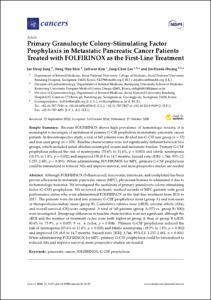KUMEL Repository
1. Journal Papers (연구논문)
1. School of Medicine (의과대학)
Dept. of Internal Medicine (내과학)
Primary Granulocyte Colony-Stimulating Factor Prophylaxis in Metastatic Pancreatic Cancer Patients Treated with FOLFIRINOX as the First-Line Treatment
- Keimyung Author(s)
- Shin, Dong Woo
- Department
- Dept. of Internal Medicine (내과학)
- Journal Title
- Cancers
- Issued Date
- 2020
- Volume
- 12
- Issue
- 11
- Keyword
- pancreatic cancer; FOLFIRINOX; G-CSF prophylaxis
- Abstract
- Simple Summary:
Because FOLFIRINOX shows high prevalence of hematologic toxicity, it is meaningful to investigate of usefulness of primary G-CSF prophylaxis in metastatic pancreatic cancer patients. In this retrospective study, a total of 165 patients were divided into G-CSF user group (n = 57) and non-user group (n = 105). Baseline characteristics were not significantly different between two groups, which included initial absolute neutrophil counts and metastatic burden. Primary G-CSF prophylaxis reduced the risk of neutropenia (55.6% to 31.6%, p = 0.003) and febrile neutropenia (18.5% to 1.8%, p = 0.002) and improved OS (8.8 to 14.7 months; hazard ratio (HR): 1.766, 95% CI: 1.257–2.481, p = 0.001). When administering FOLFIRINOX for MPC, primary G-CSF prophylaxis could be rationalized to reduced AEs and improve survival, and more prospective studies are needed.
Abstract:
Although FOLFIRINOX (5-fluorouracil, leucovorin, irinotecan, and oxaliplatin) has been proven efficacious in metastatic pancreatic cancer (MPC), physicians hesitate to administer it due to its hematologic toxicities. We investigated the usefulness of primary granulocyte colony-stimulating factor (G-CSF) prophylaxis. We reviewed electronic medical records of MPC patients with good performance status who were administered FOLFIRINOX as the first-line treatment from 2011 to 2017. The patients were divided into primary G-CSF prophylaxis users (group A) and non-users or therapeutic/secondary users (group B). Cumulative relative dose (cRDI), adverse effects (AEs), and overall survival (OS) were compared. A total of 165 patients (group A (57) vs. group B (108)) were investigated. Intergroup differences in baseline characteristics were not significant, although the cRDI and the number of treatment cycles were both higher in group A than in group B (cRDI: 80.6% vs. 73.9%, p = 0.007; 9 vs. 6 cycles, p = 0.004). Primary G-CSF prophylaxis reduced the risk of neutropenia (55.6% to 31.6%, p = 0.003) and febrile neutropenia (18.5% to 1.8%, p = 0.002) and improved OS (8.8 to 14.7 months; hazard ratio [HR]: 1.766, 95% CI: 1.257–2.481, p = 0.001). When administering FOLFIRINOX for MPC, primary G-CSF prophylaxis could be rationalized to reduced AEs and improve survival; more prospective studies are needed.
- Keimyung Author(s)(Kor)
- 신동우
- Publisher
- School of Medicine (의과대학)
- Citation
- Jae Hyup Jung et al. (2020). Primary Granulocyte Colony-Stimulating Factor Prophylaxis in Metastatic Pancreatic Cancer Patients Treated with FOLFIRINOX as the First-Line Treatment. Cancers, 12(11), 3137. doi: 10.3390/cancers12113137
- Type
- Article
- ISSN
- 2072-6694
- Source
- https://www.mdpi.com/2072-6694/12/11/3137
- Appears in Collections:
- 1. School of Medicine (의과대학) > Dept. of Internal Medicine (내과학)
- 파일 목록
-
-
Download
 oak-2020-0230.pdf
기타 데이터 / 540.87 kB / Adobe PDF
oak-2020-0230.pdf
기타 데이터 / 540.87 kB / Adobe PDF
-
Items in Repository are protected by copyright, with all rights reserved, unless otherwise indicated.